Donna Smallin Kuper's Blog: The One-Minute Organizer Blog, page 6
April 19, 2019
How Crocodiles Inspired An Earth Day Challenge
You know I don’t like clutter. But do you know what I dislike even more than clutter? Litter.
I’ve always been committed to the philosophy of leaving your “campground” cleaner than you found it. If I’m out for a walk and see a stray plastic bag, I’ll start filling it with trash I find along the way. If I see someone throw trash on the ground, I will pick it up and hand it back to the offender saying, “Excuse me, but you just dropped this!”
Litter in paradise
My husband and I just got back from a vacation in Belize. He wrote about our travels here. We went to San Pedro on Ambergris Caye. This once sleepy fishing village is now the number one tourist destination in all of Belize. It was our first visit to Belize and as you can see from the photos in Mike’s blog posts, it’s quite beautiful.
Except for all the litter.
I was sickened to see trash along the shoreline in town and all along the road north to the resort where we stayed. From the road signs I saw, I got the impression that the country is trying to educate its residents (and tourists) to put trash in its place and to recycle when possible.
We had a wonderful time in Belize, but visions of litter are etched in my memory.
Let’s commit to one act of green
Back in the U.S.A and with Earth Day 2019 upon us, I am challenging myself (and you) to commit to at least one earth-friendly act. It could be making a donation to the Keep America Beautiful organization. Or opting to replace plastic food wrap with beeswax food wrap, that you can wash and re-use. Or maybe fixing something instead of trashing it and buying new.
For more ideas, check out these Earth Day tips.
I had a reusable water bottle that recently started leaking. So I just ordered one of these. What will you do as your earth-friendly act?
The post How Crocodiles Inspired An Earth Day Challenge appeared first on Declutter Your Life with Donna Smallin Kuper.
March 27, 2019
Don’t Forget to Spring Clean Your Cleaning Tools
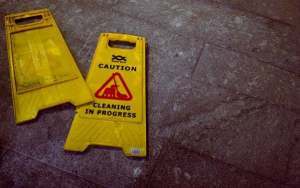 The right tools make any job easier and that’s especially true when it comes to cleaning. But are you trying to clean with dirty cleaning tools? Or cleaning tools that are in need of repair or replacement?
The right tools make any job easier and that’s especially true when it comes to cleaning. But are you trying to clean with dirty cleaning tools? Or cleaning tools that are in need of repair or replacement?
What’s in your cleaning closet?
Take a look at what’s in your cleaning closet or wherever you keep your cleaning tools and supplies. Is your vacuum cleaner in good working order? Is your broom or mop head worn out?
Make a note to repair or replace cleaning tools or purchase replacement accessories as needed. Remove any tools that are broken or no longer needed. If they’re still in working order, donate to your favorite local charity or offer them on your local Buy Nothing group on Facebook or Freecycle community.
How to clean your cleaning tools
After decluttering your cleaning closet, here’s how to clean your cleaning tools…
Broom – Vacuum bristles. Wash in soapy water and rinse. Stand with bristles up to dry.
Mop – I toss my microfiber mop head in the washing machine along with my microfiber cloths. If you have a sponge-type mop head, dunk it in a bucket of warm water with a few drops of dishwashing liquid. Use your hands to squeeze the suds through the sponge. Empty the bucket and refill with fresh water. Keep squeezing water through the sponge to remove suds. Rinse under running water to remove the last of the suds. Allow to air dry thoroughly before returning to your cleaning closet. Replace sponge mop heads every few months.
Vacuum cleaner – Empty the bag or canister if it’s more than two-thirds full. Wipe the outside of your vacuum cleaner and cord with a damp, soft cloth. Remove bits of thread, hair, and other debris from the roller brush – scissors may be needed. Remove the air filter and wash in hot, soapy water and then rinse and air dry completely before replacing it your machine. This should actually be done monthly.
Microfiber cloths – Machine wash microfiber cloths in hot water with a little detergent and dry on the delicate cycle or air dry. Do not wash microfiber with any other fabrics as lint will become trapped in the microfiber and lessen its effectiveness. Do not use fabric softener. When properly cared for, microfiber cloths should last for approximately 50 washings.
A few of my favorite cleaning tools
While we’re on the subject of cleaning tools, I thought I’d share a few of my new and old favorites.
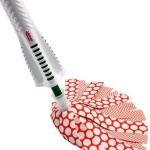 For mopping, most professional house cleaners use a string mop. Why? Because using a swabbing motion with a string mop, you can cover more floor faster than with a sponge mop head. And it won’t leave streaks. I’m a big fan of the Libman Wonder Mop. It’s like a string mop except that instead of strings, it’s got strips of microfiber fabric. Microfiber is so effective at removing dirt and germs, all you need is water to get your floors squeaky clean.
For mopping, most professional house cleaners use a string mop. Why? Because using a swabbing motion with a string mop, you can cover more floor faster than with a sponge mop head. And it won’t leave streaks. I’m a big fan of the Libman Wonder Mop. It’s like a string mop except that instead of strings, it’s got strips of microfiber fabric. Microfiber is so effective at removing dirt and germs, all you need is water to get your floors squeaky clean.
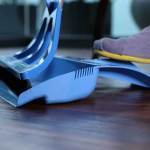 I recently replaced my worn-out broom after watching Shark Tank one night. The inventor of The Wisp was on the program and I knew right away that this was the broom for me. I love it when I’m right! This broom is the best broom I’ve ever used. With my old broom, I could see a lot of dust in the air while sweeping, which would eventually settle back on the floor. Not so with The Wisp. And it does a great job of trapping cat hair (and human hair).
I recently replaced my worn-out broom after watching Shark Tank one night. The inventor of The Wisp was on the program and I knew right away that this was the broom for me. I love it when I’m right! This broom is the best broom I’ve ever used. With my old broom, I could see a lot of dust in the air while sweeping, which would eventually settle back on the floor. Not so with The Wisp. And it does a great job of trapping cat hair (and human hair).
But wait until you see what’s different about the dust pan works. You place it on the floor and step on the back which makes the front edge hug the floor. So when you sweep debris into the dust pan, you don’t have to chase that line of dirt that most dust pans leave behind. There’s even a serrated edge on each side of the dust pan designed for cleaning the bristles after use. The catch? Well, it costs more than a regular broom, but I think you’ll agree after using it, that it’s worth every penny because it comes with a lifetime warranty on the bristles. So it may very well be the last broom you’ll ever need to buy!
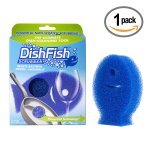 In a recent blog post, I warned you about using germ-y sponges. Then I was introduced to DishFish sponges. Most sponges stay wet after cleaning, becoming a breeding ground for bacteria and odors. DishFish sponges are designed to stand up on their tails, so they dry faster. And these sponges are made from specialized polyurethane foam infused with an antimicrobial, a material that reduces the spread of E. Coli by up to 90%. Bottom line: The DishFish only has to be replaced every 6 to 12 weeks vs. 1 to 2 weeks with other sponges.
In a recent blog post, I warned you about using germ-y sponges. Then I was introduced to DishFish sponges. Most sponges stay wet after cleaning, becoming a breeding ground for bacteria and odors. DishFish sponges are designed to stand up on their tails, so they dry faster. And these sponges are made from specialized polyurethane foam infused with an antimicrobial, a material that reduces the spread of E. Coli by up to 90%. Bottom line: The DishFish only has to be replaced every 6 to 12 weeks vs. 1 to 2 weeks with other sponges.
Whether you are just starting your spring cleaning or just starting to think about it, don’t forget to clean your cleaning tools! And keep them clean for a healthier home.
The post Don’t Forget to Spring Clean Your Cleaning Tools appeared first on Declutter Your Life with Donna Smallin Kuper.
March 20, 2019
Get Happy by Clearing Clutter
 The International Day of Happiness is celebrated worldwide every March 20, which also happens to be the first day of spring this year.
The International Day of Happiness is celebrated worldwide every March 20, which also happens to be the first day of spring this year.
What can you do today to improve your happiness? How about making today the day you commit to clearing clutter in your home?
Clear the clutter, find happiness
I’m a firm believer that less mess equals less stress and that can lead to a happier, healthier home. Studies have shown that not only does an uncluttered home reduce stress and increase happiness, it can also improve your relationships and even your eating and exercise habits.
Clearing clutter doesn’t mean throwing everything out. It means figuring out what’s important – and what’s not – at this point in your life.
Can’t bear to part with memorabilia from your world travels? Then don’t. Got boxes of hobby stuff from hobbies you used to enjoy, but no longer do? Pass them on to someone who will really appreciate them. Offer them in your local Freecycle.org community or Buy Nothing group on Facebook.
To keep or toss?
Make the decision to free yourself from the bits and pieces of your life that are no longer meaningful – and maybe never were. That includes gifts and things you may have inherited. Just because they ended up in your possession doesn’t mean you have to be their keeper forever.
Give yourself permission to let go of anything you no longer love or use. If it takes more than 60 seconds to decide if you should keep something, it’s probably not that important to you.
How much is enough? When you reach a point when you feel that you have everything you need and nothing you don’t want, that’s the right amount of stuff for you.
Simple tips for clearing clutter one day at a time
There’s no time like the present to get started on creating a happier home. Gretchen Rubin, author of The Happiness Project says: What you do every day matters more than what you do once in a while.
With that in mind, here are some simple everyday tips for clearing clutter.
Make time to declutter. Spending just 15 minutes a day adds up to 7 hours a month. You can do a lot of decluttering in 7 hours.
Develop the habit. Get into the habit of decluttering by linking it to something you always do. For example, after you eat dinner, empty a drawer and put back only the things you love and/or use. Or grab a bag and toss in 10 things that are just taking up space in your home. When the bag is full, donate it.
Do it now. When you see somethings that needs to be picked up and put away, take a few minutes to do it now rather than later. Your future self will thank you.
Act like an organized person. Who do you know whose home always looks the way you want your home to look? Next time you are about to toss something on your kitchen counter or table, ask yourself: What would [name of that person] do? The more you act like an organized person, the more organized you’ll become.
Get help. If you are struggling to clear clutter from your home, join my free organizing support group on Facebook. This is a private group where you can ask questions and get answers and be inspired to declutter, organize, and simplify your life.
As you’re clearing clutter from your home, think twice before bringing in new items. Being more intentional about what you buy is the easiest way to keep future clutter at bay. It also frees up funds that can be diverted to your bank account or toward doing something you’ve always wanted to do. I don’t know about you, but that makes me happy!
The post Get Happy by Clearing Clutter appeared first on Declutter Your Life with Donna Smallin Kuper.
March 8, 2019
8 Cleaning Habits to Enhance Your Health and Well-Being
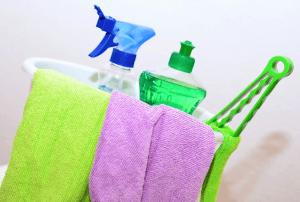 A clean home is a happier, healthier place to live. The challenge is keeping it clean. These 8 cleaning habits will not only help maintain a clean home, but also enhance the physical and mental health and well-being of you and your family. How many of these cleaning habits are you practicing on a regular basis?
A clean home is a happier, healthier place to live. The challenge is keeping it clean. These 8 cleaning habits will not only help maintain a clean home, but also enhance the physical and mental health and well-being of you and your family. How many of these cleaning habits are you practicing on a regular basis?
Make your bed
Whether you are rushing to get ready for work, or getting the kids ready for school, there is always an excuse to skip making the bed. But, believe it or not, making your bed in the morning can set a positive tone for your entire day.
It may seem small, but it is your first accomplishment of each day. It will help you to feel organized and ready to take on the rest of the day. Research has also found that making your bed can improve your productivity and increase your happiness.
By making the bed in the mornings, your bedroom will appear neater and more presentable and you won’t have to come home to a messy bedroom.
Lose the shoes
Research conducted by the University of Houston found that 40% of our shoes were carrying potentially harmful strains of bacteria, such as C. diff and E.coli. If this wasn’t bad enough, our shoes often carry in mud and other unwanted dirt, which then travels throughout the home.
Getting into the habit of taking off your shoes as soon as you get through the door will keep your flooring in better condition, keep the floors cleaner for longer and stop the spread of bacteria.
Turn housekeeping into a workout
Only 23% of American adults get the recommended 150 minutes of exercise a week. This is not surprising considering the hectic lives that many of us lead.
So, if you are struggling to find time to get to the gym, why not turn housekeeping into a workout?
Be sure to set aside 30 minutes per cleaning session and keep your heart rate up. Intensity is they key! Try adding simple exercises to your everyday chores, such as lunges while mopping or vacuuming or squats and toe raises while doing the dishes. It may not completely replace going to the gym, but it is a great way to start getting fit and keep your house clean at the same time.
Keep your phone clean
We use our phones everywhere from public transport to work to the supermarket, and we often don’t think twice when we come home and place our phone on the kitchen counter.
But believe it or not, a recent study has found mobile phones carry 10 times more bacteria than most toilet seats! While not all of this bacteria is harmful, is still poses a threat to the well-being of our homes.
Giving your phone a quick clean with a microfiber cloth, once a day, is a simple habit you can do to keep yourself and your home healthier.
Declutter regularly
From piles of newspapers, letters and old receipts to drawers stuffed with clothes you haven’t worn in years, we all know how easily clutter can build up.
Clutter can have a significantly negative impact on our mental well-being, so it is important to get into the habit of dedicating an hour or so each week to decluttering your home.
Decluttering will enhance your well-being by reducing stress, boosting productivity levels and reducing the allergens and dust in your home. Tackle the clutter room by room, to make the task less daunting.
Go green
Green cleaning is a growing trend and it is a great way to rid your home of the dangerous chemicals often found in commercial cleaning products.
Natural cleaning products can improve your home’s air quality and create a healthier family environment. Going green is also a great way to save money.
Raiding your kitchen cupboards is a good way to begin building up your green cleaning starter kit. Lemons, salt and baking soda are just a few of the kitchen staples that have great natural cleaning properties. For instance, lemons are great for cleaning drains, deodorizing refrigerators and cleaning copper pots and pans!
Remember to clean hot spots
Door handles and light switches are hot spots for bacteria. What makes it worse is that we constantly come into contact with these areas, yet they are often neglected when it comes to cleaning the home.
It is essential to clean these neglected areas regularly, especially during cold and flu season. Cold and flu viruses can survive on hard surfaces for up to 18 hours and can multiply if left uncleaned.
If using a sanitizing or disinfecting spray, remember that it must be left for 30-60 seconds before wiping off to effectively remove germs.
Don’t forget your sponges
How often do you clean your kitchen sponge?
We are often so busying trying to keep the house clean, that we forget to clean our cleaning equipment. However, cleaning with dirty sponges and dishcloths can spread potentially harmful bacteria throughout our homes, making all of our hard work pointless. In fact, kitchen sponges are one of the dirtiest items in our homes.
So, be sure to get into the habit of cleaning your sponges and dishcloths a few times a week, keeping them dry to prevent bacteria growth and replacing them every 1-2 weeks.
 Leah Felix is a marketing intern for TidyChoice, an online marketplace for independent cleaners. She writes original blog content on home cleaning and family life for the TidyChoice blog.
Leah Felix is a marketing intern for TidyChoice, an online marketplace for independent cleaners. She writes original blog content on home cleaning and family life for the TidyChoice blog.
The post 8 Cleaning Habits to Enhance Your Health and Well-Being appeared first on Declutter Your Life with Donna Smallin Kuper.
February 27, 2019
Apps That Simplify Your Life + Save Time and Money

Photo by Yura Fresh on Unsplash
What did we do before we had the Internet? And smartphone apps? It seems like whatever you want to do, there’s an app for it – shopping, banking, fitness, reminders, you name it.
I thought it might be fun to share some of our favorite apps, especially those apps that simplify your life, plus save time and money. You’ll find 14 of my favorite apps below – all free unless otherwise noted.
This is a blog post I’ve been meaning to write for quite some time now and I’m looking forward to reading your comments and suggestions!
Financial
Have you ever used the Google Pay (or Apple Pay) to pay for a purchase? It’s so easy – and because your credit/debit card number is encrypted, it’s actually safer than using your physical card. As long as you have your phone, you have money! Just hold your phone to the pay terminal wherever you see the Google Pay or Apple Pay logo.
As an added convenience, you can use this app to send money to someone. In the Google Pay app (and probably the Apple Pay app as well), you can also enter gift cards and loyalty program cards so it’s all right there in your “digital wallet.”
I bank with Chase and I love the Chase Bank app. I’ve used it to transfer money on the fly from one account to another when I was short on cash for a purchase. And I use it to deposit checks by taking a photo with my phone. No more driving to the bank and standing in line!
I use the Shoeboxed app to store all of my business receipts as digital documents. You can scan paper receipts with the Shoeboxed app or forward digital email receipts to your Shoeboxed account. Easy peasy and no paper clutter!
I use the free version which is designed for light use. But there are reasonably priced options for heavier use that allow you to mail in receipts and they do the scanning for you. That option could be a good solution if you need to scan a lot of receipts like I did when we downsized to our home on wheels. Sign up with this link to get 10% off your first year of paid service.
Shopping
I’ve always been a big proponent of making lists. Having a shopping list is a good way to avoid impulse purchases and also gets you in and out of stores faster. I’ve been using the Out of Milk app for years now to keep my grocery shopping list and also my drug store list (it seems like I’m always running to CVS!)
If I’m running low on something, I grab my phone and add it to my list. You can have as many lists as you want and also share your lists with another person via text message or email. This free app also includes a handy To-Do List which is helpful for keeping track of errands.
I mentioned CVS – and I like the CVS app. People joke about how long CVS receipts are because they include coupons for future purchases. But what a lot of people don’t know is that you can opt to receive email receipts – and you can do that very easily on the app. When your digital receipt arrives in your inbox, just click to “send” those coupons to your card so that your discounts come up automatically at the register.
Plus, with the app, you can schedule a MinuteClinic Video Visit with a doctor – something I did for the first time recently and yes, I would do it again. The cost for my video phone visit was just $59 and I was very pleased with the service.
About a year ago, a friend introduced me to the Ibotta app that gives you cash back for purchases you’d be making anyway. You’ll find offers from a variety of retailers as well as online retailers such as 1-800-Flowers, Amazon, Expedia, Groupon, and many more. To maximize your savings, always go to the Ibotta app first before making any online purchase or going to your grocery store. I mostly use this app to save on groceries (because that’s mostly all I buy!).
Before going to the store, I check to find Ibotta offers in every category from produce, meats, and dairy to wine, beer, and spirits. Then I use the app to scan my receipt – you can also link a loyalty card to your Ibotta account. It’s free to sign up and once you hit $20 in savings, you can transfer the cash into your PayPal or Venmo account or use your cash back to purchase a gift card through the app.
Meal Planning & Recipes
I sure wish I had a dollar for every time I recommended the Paprika app! This is where I store recipes I’ve downloaded from web sites, one of my favorite past times. I just copy the URL into the Paprika browser and click save. You can manually enter recipes, too, using cut and paste.
All of the recipes I download are put into the same format, which is very nice and I can share recipes via text or email. Other features I love…
Scale any recipe to double it, make half, or whatever.
Organize recipes by categories such as seafood, side dishes, and desserts.
Edit recipes to suit your personal preferences.
Add recipe ingredients to your grocery list (another feature on the app)
Create weekly meal plans with your selected recipes.
Living in a small space as I do, I don’t have room for cookbooks. I just grab my phone, open the Paprika app, and start cooking.
Travel
Have you ever heard of the TripIt app? I use the free version and love it. You can forward your airline, hotel, car rental and other travel email itineraries to your TripIt account, so you have them all in one place.

Me and my “grocery getter”
Since becoming a full-time RVer, my only vehicle is a motorcycle. But if it’s too cold or rainy (or I want to wear a dress), I will use either the Lyft or Uber app to get a ride to my destination. These ride-hailing companies cost less than a taxi and because the driver owns the vehicle, the condition of the car and driving are typically superior.
If I’m not in a hurry, I will often select the ride-share option which means that we may pick up another passenger along the way, resulting in a lower cost to me. But guess what? If we don’t pick up anyone along the way, I still benefit from the lower cost.
Bonus savings: Sign up for Uber with this link and get $2 off each of your first three rides. (Uber will thank me with discounts too!)
Fitness
I believe that healthy living can simplify your life by creating a happier mind, body, and spirit. I have two favorite fitness apps that I use regularly.
One is the MyFitnessPal app – I use this to track my daily calorie intake. You can search for food items or scan bar codes and, to make it easier on yourself, you can copy meals from one day to another. I also enter my exercise minutes for the day. Since I started tracking my food and exercise, I’ve managed to shed 35 pounds. I use the free version, but there’s a Pro version as well if you want more insights.
The other fitness app that I recommend is 7 Minute Workout. It’s like having a personal trainer! The workout consists of a series of exercises that you perform for 30 seconds with a 10-second rest in-between. And it works out every muscle group. Who says you don’t have time for a workout?
Reminders, Notes & To-Dos
How many times have you not had a paper and pen handy to jot down a note? It’s time to get with the 21st century and make digital notes. I use Note on my Android phone to write down things I need to remember, ideas, and other notes. You can also create checklists for things to do.
Okay, this last tool I use is not an app, but I’m including it in this post because it can really help you stay on top of upcoming events and follow up items. It’s the FollowUpThen reminder tool. Let’s say you get an email with directions to a St. Patrick’s Day party. Simply forward the email to March17@followupthen.com and it will come back you on that date. Or maybe you get an email that requires your attention in three days – forward to 3days@followupthen.com. Who’s the organized one now? You!
So there you have it. Those are some of my favorite apps that help simplify your life, plus save time and money. Now it’s your turn to share!
The post Apps That Simplify Your Life + Save Time and Money appeared first on Declutter Your Life with Donna Smallin Kuper.
February 21, 2019
The Procrastinator’s Guide to Getting Organized

Photo by Gaelle Marcel on Unsplash
Has “get organized” been on your to-do list for what seems like forever?
If you tend to put it off rather than plunge in or dawdle instead of do, you’re procrastinating. The question is why. The answer is somewhere in that head of yours.
Maybe the thought of getting organized makes you feel overwhelmed, frustrated, or even afraid. It’s hard to get anything done in that state of mind, wouldn’t you agree? The trick is to change how you think and feel about getting organized. I call that “getting your brain in gear.”
Envision success.
Imagine walking into your uncluttered kitchen or office. Envision it. What do you see? How do you feel? What might your family members and friends say to you if they could see your newly organized space? Focus on a successful outcome.
Make it easy on yourself.
Organizing is a decision-making process. We need to make decisions about what to toss and what to keep as well and where to put what. To simplify the decision-making process, develop a few umbrella rules such as:
* If I haven’t used it in a year or more, I will let it go.
* If I love it or think it is beautiful, I will keep it.
* If I could get another one fairly easily and/or inexpensively, it’s outta here.
Forget about perfect.
Believe it or not, perfectionists are some of the biggest procrastinators. You could be one of them if you put things off because 1) you don’t feel you enough time to do the job right, 2) you don’t have the “perfect” tools for the job, 3) you haven’t yet figured how to do the job perfectly, or 4) all of the above.
When you set perfection as your goal, you rarely achieve it because perfection is elusive. Instead, set your goal to simply get the job done as quickly as possible. You can always perfect it later. But don’t be surprised if you discover that “done” is perfect.
Tackle today’s stuff.
Instead of hoping that someday you’ll get organized, start by organizing today’s stuff. For example:
* If you sort through your mail every day, you will be less likely to miss payments on bills or important events.
* If you hang up your clothes when you take them off, you won’t have a whole pile of wrinkled clothes on the floor that will later need dry cleaning or ironing.
* If you get into the habit of putting things down where they belong, you will be able to find them when you need them.
Once you organize your everyday life, you can begin to set aside time to work on selected projects such as decluttering your pantry or organizing your closet.
Start small.
Stop thinking about how you have to get your whole house organizing. Start by decluttering a small space such a drawer, desktop, medicine cabinet, purse, glove compartment or trunk – something that you can complete quickly. Seeing the result of your efforts will increase your confidence in your ability to get organized and motivate you to do it again.
Make it fun.
Consider inviting a friend to help organize your closet in return for your help at his or her home. Organizing is more fun when you have an organizing buddy and four hands make quicker work than two. (You might also consider joining my Organizing Support Group on Facebook where you can participate in our regular “Saturday Shakeout” and other group organizing projects.)
Reward yourself.
Before you begin, establish a reward for getting the job done. For example, you might decide to reward yourself after one hour of organizing by putting your feet up for 15 minutes and relaxing with a good book or your favorite magazine. Or add a bouquet of fresh flowers to your grocery shopping list for planning your meals for the week.
The post The Procrastinator’s Guide to Getting Organized appeared first on Declutter Your Life with Donna Smallin Kuper.
February 14, 2019
Declutter Ethically – How to Responsibly Discard Unwanted Stuff

Photo by Alina G on Unsplash
Cleaning out closets might be the great American past time for 2019. Inspired by the new Netflix show, Tidying up with Marie, Americans are diving in headfirst to the task of simplifying their belongings.
Offloading unwanted stuff is a positive trend—our homes will feel lighter, more manageable and more organized. But what we do with unwanted stuff will mark whether this latest declutter movement will be a good thing for the nation and our world.
Don’t Just “Throw Away”
One of the complaints about the “KonMari System”as Marie Kondo, author of The Life-Changing Magic of Tidying Up, calls it, is that when she calls for an item to be discarded, she sometimes says “throw away.” Of course, if every person tossed everything which no longer “sparked joy” for them, the landfills would not be able to hold the volume.
Decluttering our homes is a good thing, but in order for that good to be effective, we must discard the thing leaving our possessions thoughtfully and respectfully.
Here are some guidelines to declutter ethically. When you are de-owning things, try to get rid of them in the following order:
1) Give directly away to someone who genuinely needs (or wants) the item.
Items best given directly are family heirlooms—that quilt your grandmother made might mean more to your niece than it does to you. Also in this category? High-quality items that could save a friend or family member some money if they are going to purchase a similar thing anyways. When you gift items, make sure that the other person genuinely needs or wants it instead of merely using this as an excuse to offload stuff.
2) Sell the thing.
Selling stuff is a good idea if the items are worth enough money to offset the hassle of selling and/or shipping. If you have items which are worth selling and the profit is a good enough margin to “pay off” the trouble of listing it online or taking it to ship, then go for it.
3) Donate the item to smaller, local programs that you can get to know and get involved in.
If you’re not going to give the item away directly or sell it, then a small, reputable program might be your next best place to take items. Smaller, local shelters or aid programs are great because often they have a better handle on exactly what is needed and how the items are being used. You can also get involved by volunteering and fostering local partnerships. Helping your local shelters and aid programs is a great way to strengthen your very own community.
4) Donate the item to a well-reputed larger donation store.
Charity resell stores such as Goodwill, Oxfam or the Salvation Army are okay for dropping off your unwanted goods. The items are not going to landfills (yet); shopping second-hand is a super way to go green. Do research to find out which of these charity resell shops has the best reputation and financial transparency in your area.
5) Discard the items appropriately.
For items that are not sellable or in good enough condition to donate or give away, make sure you discard the thing appropriately. Take threadbare or stained clothing to a textile recycling program which will reuse the fibers to create a new product. Reuse old clothing as painting shirts or cleaning rags.
Ripped or stained towels or blankets can be donated to pet rescue programs. Take mattresses to a mattress recycling program—most can be dismantled and the parts can be reused in different products.
Always dispose of hazardous waste carefully. Take paint, batteries, electronics and the like to hazardous waste centers or electronic recycling centers.
6) Discard in rash/landfill as a last resort.
Try to save the landfill bin as a last resort for discarding items. Many things can be upcycled and reused for a plethora of different uses. Just remember that there is no “away.” When you toss something in the trash, it still exists in a landfill. Let’s do our best to save space in those landfills and not overburden the earth with the weight of our unwanted junk.
As we declutter and lighten up our homes, we have an opportunity to make a positive impact on this planet for generations to come. We can eek out every last bit of usability from the items we own. We can do our best to ensure that the things leaving our ownership are discarded appropriately. And we can think twice about what we bring into our homes to reduce the volume of stuff that has to be discarded later.
Evelyn is a writer and speaker who encourages women to uncover their best by living with less. She is passi onate about functional minimalism, home educating her four young children, faith and intentionally “living small.” Find her thoughts at www.smallishblog.com.
onate about functional minimalism, home educating her four young children, faith and intentionally “living small.” Find her thoughts at www.smallishblog.com.
The post Declutter Ethically – How to Responsibly Discard Unwanted Stuff appeared first on Declutter Your Life with Donna Smallin Kuper.
January 22, 2019
What Your Clutter Would Say If It Could Talk
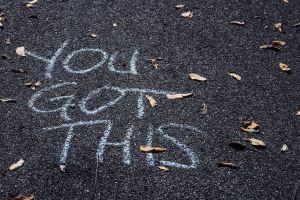
Photo by sydney Rae on Unsplash
If you often can’t find what you need when you need it…
If you have more than one junk drawer or an entire junk room…
If your garage is more of a storage space than a place to park your car…
If your kitchen counter, dining room table, or desk is piled with paper and other stuff…
If just the thought of trying to declutter your home is overwhelming…
Your clutter is trying to tell you something. But what?
Here are four things I think your clutter would say if it could talk.
“You dumped me.”
What happens when you’re in the habit of setting things down instead of putting them away? Clutter happens. Believe me, it’s a lot easier to take a few moments now to put something away than it is to have to pick up and put away a lot of things later.
Everything you own should have a home. The best home for a thing depends on what it is and how often you need to access it. If it’s something you use often, store it in an easily accessible place, preferably near to where you will use it. Example: Store cooking utensils in a jar on your kitchen counter near your stove top and makeup in a portable makeup bag or bin under the counter.
A real mess maker is when we decide we no longer love or use certain items, but instead of releasing ownership, we dump them in a closet, spare room, or garage. Sometimes we keep this stuff because we’re afraid we might need it in the future. (You won’t and if you do, you can probably get it again pretty easily and inexpensively.) Or we just don’t know what to do with it because it’s still perfectly good. (Donate or sell it.)
“I forgive you.”
Guilt is another reason why clutter accumulates in our homes. You think about how much you paid for something – or overpaid – and you feel guilty about that or regret it. If only you could go back in time and and un-buy the thing, but of course you can’t. What you CAN do is forgive yourself and move on.
The good news is that if you have clutter, you’re richer than you think. Sell some of that stuff now while it still has value. The longer you hold on to it, the less it’s worth. Forget about having a yard sale though. It’s too much work for too little return in my humble opinion.
Faster, easier ways to sell things are through the OfferUp app, Craigslist, and Facebook Marketplace in your area. I’ve sold all kinds of things this way – everything from an old kitchen faucet set to a kayak to a digital blood pressure monitoring system. It’s easy to do. You just take photos of the item and write a brief description, then post your ad.
“Please let me go.”
Would you go out today and buy clothing that’s three sizes too small? No. Or supplies for a hobby you gave up years ago? Uh, nope.
What about things you’ve been given or inherited? Would you buy them today? If no, give yourself permission to let them go.
Keep in mind that items you inherited weren’t intended for you. Your loved ones purchased those items for themselves. And just because they are in your possession now does not mean that you have to be their keeper forever, especially if having them in your home makes you unhappy or brings back sad memories.
If it’s hard to part with sentimental items, take photos or write about the items and your memories of people who have passed on in a beautiful journal that you can cherish forever. And then donate or sell that stuff and give it a chance for a new life where it will be loved and used. If you sell items you inherited, you may want to donate the money to a charitable cause in the original owner’s name. Or honor his/her memory with a plaque on a park bench.
“You have too much stuff.”
If you’re thinking that you need a bigger home, more storage space, or a storage unit, stop right there. Maybe what you really need is less stuff.
Clutter detracts from our lives in ways we don’t even realize. It gets in our way. It steals our time, energy and attention. It keeps us stuck in our UNhappy place. And it creates unnecessary stress in our lives.
Imagine if you woke up tomorrow and all that stuff you no longer love or use was gone. How would you feel? Tap into that feeling as you declutter your home room by room. Use it as your inspiration to get yourself unstuck from your past. Make a decision to keep only those things that are meaningful to you in the here and now. If you need support and encouragement, join my free organizing support group on Facebook.
You got this.
The post What Your Clutter Would Say If It Could Talk appeared first on Declutter Your Life with Donna Smallin Kuper.
January 10, 2019
How to Stick Your New Year’s Resolutions
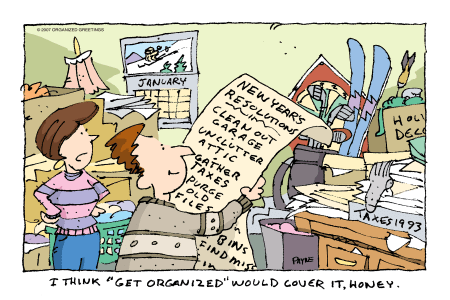 Did you make any new year’s resolutions this year? I resolved to keep off the weight I lost last year, do strength training 2-3 times week, and write more blog posts.
Did you make any new year’s resolutions this year? I resolved to keep off the weight I lost last year, do strength training 2-3 times week, and write more blog posts. How about you? Whatever you resolved, to make this the year you achieve your goal, you need to do more than just make a resolution. You need a plan.
Here’s my simple 3-step plan for making your new year’s resolutions stick.
1. Write it down.
Did you know that writing down your goals is one of the most sure ways to achieve them?
A study of Harvard graduates ten years after graduation found that only 3% had written goals, 13% had verbal goals, and the remaining 84% had no written or verbal goals. Those graduates with verbal goals were earning twice that of those with no verbal or written goals. But those with written goals were earning ten times as much.
Try this exercise:
Write down five to ten goals for 2019.
Now pick three that you would really like to accomplish in the next 90 days.
Then pick the one you feel would make the biggest difference in your life (Make that Goal #1.)
The next step is to break down that goal into tasks and write them down.
Then pick one of these tasks and begin it.
When you’re done, cross it off the list and start on the next task.
For example, if you “organize my office” is your #1 goal, your tasks might include filing papers, setting up a follow-up system, rearranging your workstation, clearing your desk, decluttering desk drawers, organizing office supplies, updating your address book, cleaning out your email box, reorganizing electronic folders on your hard drive, and so on.
2. Make yourself accountable.
One of the best things you can do (next to writing down your goals) is to have someone hold you accountable.
Share your written goals to a friend or family member and ask him or her to check in with you on a regular basis. You will be more inclined to stick with your plan if you know that someone will be asking you about your progress.
Or find an accountability buddy – someone with a similar goal. Check in with each other once a day or once a week.
3. Be consistent.
The key to success with any endeavor is consistent effort.
“Determine what specific goal you want to achieve. Then dedicate yourself to its attainment with unswerving singleness of purpose, the trenchant zeal of a crusader.” ~Paul J. Meyer, founder of Leadership Management International
Set aside 15-30 minutes a day or 1-2 hours one or two days each week. Even if you spend just 15 minutes a day, that adds up to 1 3/4 hours a week or 7 hours a month. Just think of what you can accomplish in that time! When you make progress toward your #1 goal every day, you will eventually achieve your goal. And then you can begin to tackle Goal #2.
I’d love to read about your new year’s resolutions – use the comments section below as an opportunity to write them down!
The post How to Stick Your New Year’s Resolutions appeared first on Declutter Your Life with Donna Smallin Kuper.
How to stick your new year’s resolutions
 Did you make any new year’s resolutions this year? I resolved to keep off the weight I lost last year, do strength training 2-3 times week, and write more blog posts.
Did you make any new year’s resolutions this year? I resolved to keep off the weight I lost last year, do strength training 2-3 times week, and write more blog posts. How about you? Whatever you resolved, to make this the year you achieve your goal, you need to do more than just make a resolution. You need a plan.
Here’s my simple 3-step plan for making your new year’s resolutions stick.
1. Write it down.
Did you know that writing down your goals is one of the most sure ways to achieve them?
A study of Harvard graduates ten years after graduation found that only 3% had written goals, 13% had verbal goals, and the remaining 84% had no written or verbal goals. Those graduates with verbal goals were earning twice that of those with no verbal or written goals. But those with written goals were earning ten times as much.
Try this exercise:
Write down five to ten goals for 2019.
Now pick three that you would really like to accomplish in the next 90 days.
Then pick the one you feel would make the biggest difference in your life (Make that Goal #1.)
The next step is to break down that goal into tasks and write them down.
Then pick one of these tasks and begin it.
When you’re done, cross it off the list and start on the next task.
For example, if you “organize my office” is your #1 goal, your tasks might include filing papers, setting up a follow-up system, rearranging your workstation, clearing your desk, decluttering desk drawers, organizing office supplies, updating your address book, cleaning out your email box, reorganizing electronic folders on your hard drive, and so on.
2. Make yourself accountable.
One of the best things you can do (next to writing down your goals) is to have someone hold you accountable.
Share your written goals to a friend or family member and ask him or her to check in with you on a regular basis. You will be more inclined to stick with your plan if you know that someone will be asking you about your progress.
Or find an accountability buddy – someone with a similar goal. Check in with each other once a day or once a week.
3. Be consistent.
The key to success with any endeavor is consistent effort.
“Determine what specific goal you want to achieve. Then dedicate yourself to its attainment with unswerving singleness of purpose, the trenchant zeal of a crusader.” ~Paul J. Meyer, founder of Leadership Management International
Set aside 15-30 minutes a day or 1-2 hours one or two days each week. Even if you spend just 15 minutes a day, that adds up to 1 3/4 hours a week or 7 hours a month. Just think of what you can accomplish in that time! When you make progress toward your #1 goal every day, you will eventually achieve your goal. And then you can begin to tackle Goal #2.
I’d love to read about your new year’s resolutions – use the comments section below as an opportunity to write them down!
The post How to stick your new year’s resolutions appeared first on Declutter Your Life with Donna Smallin Kuper.
The One-Minute Organizer Blog
- Donna Smallin Kuper's profile
- 45 followers




